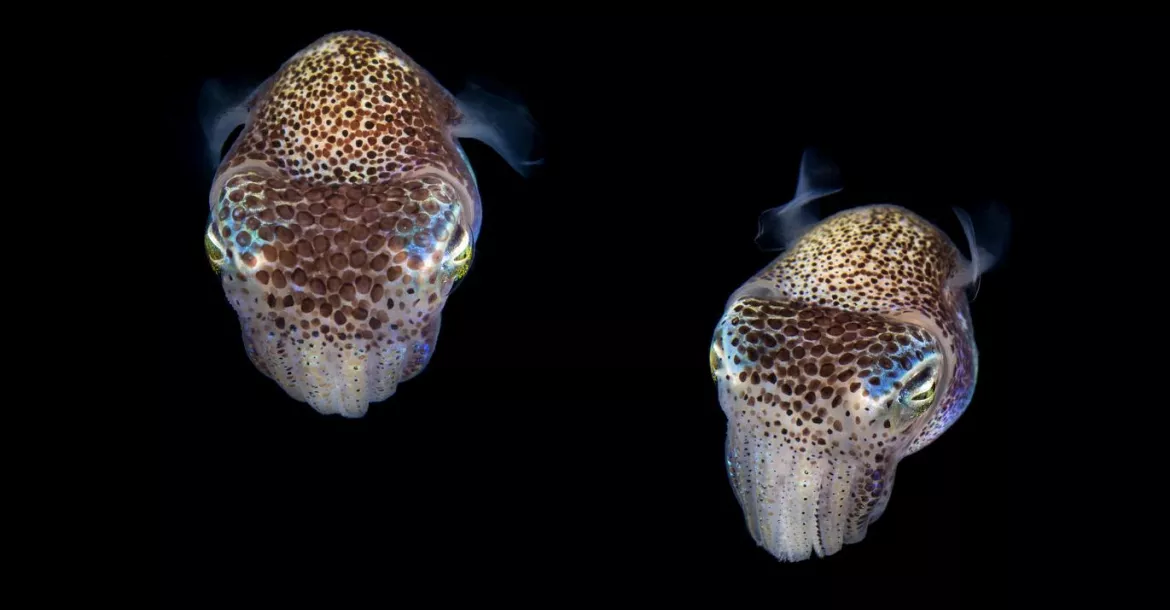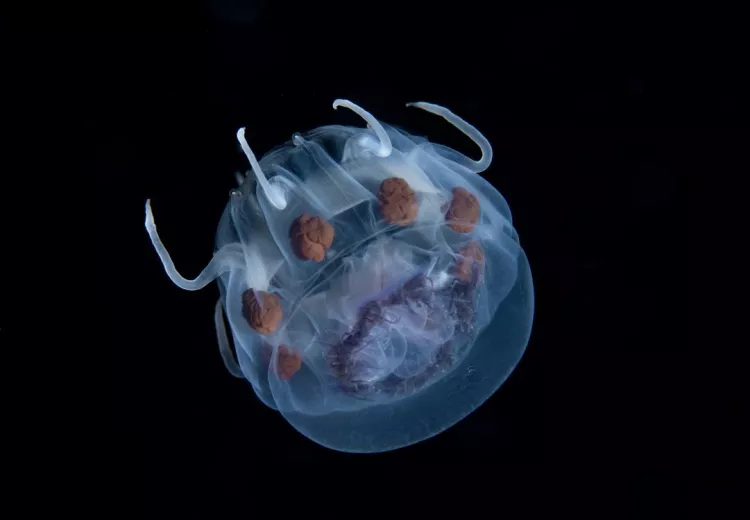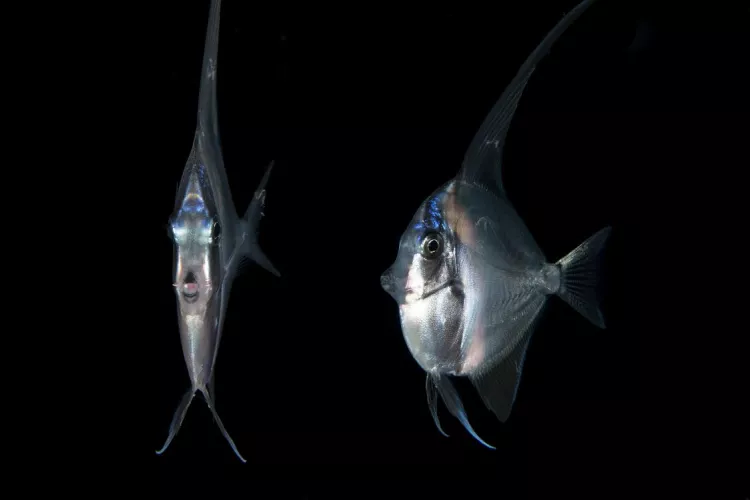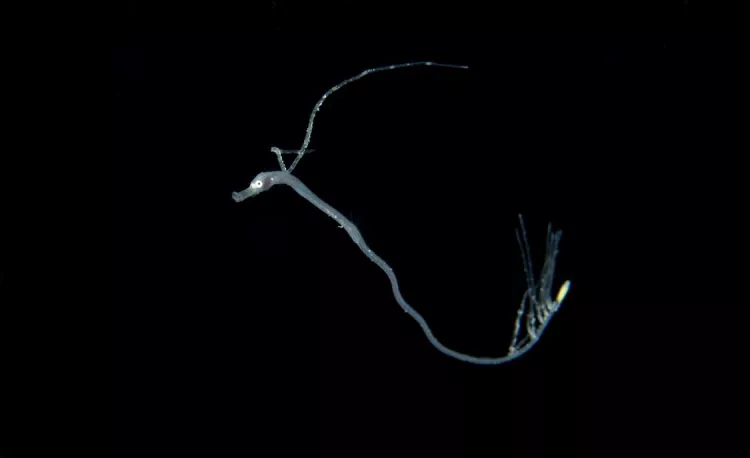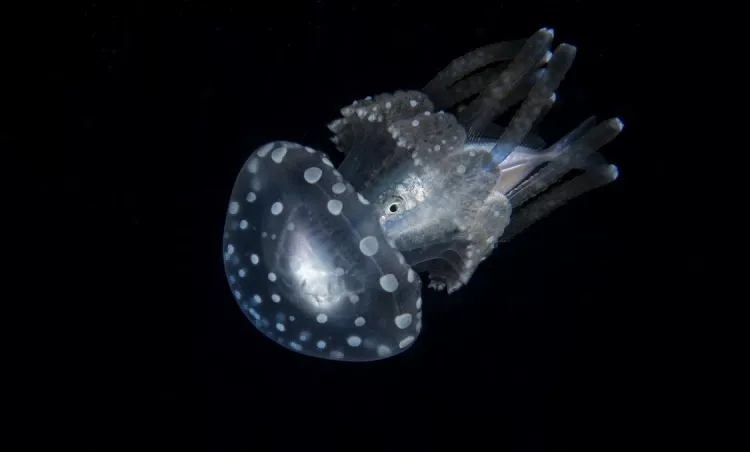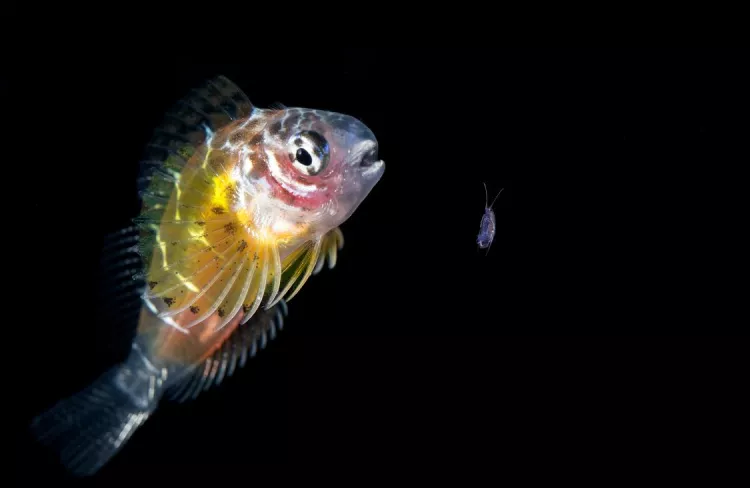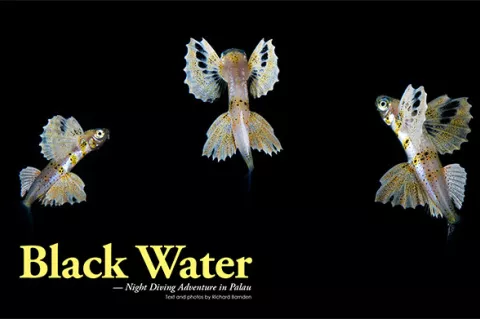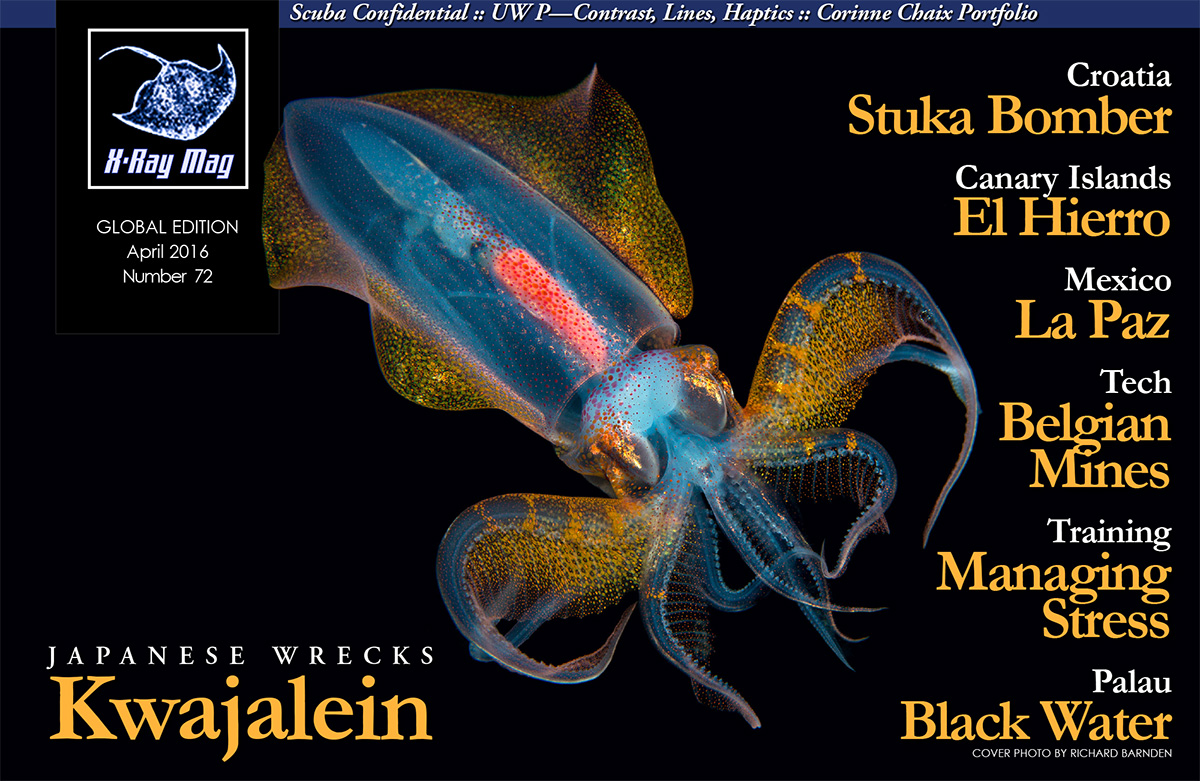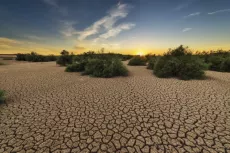The original concept of black water diving consists of going to an offshore location in the middle of the ocean at night and jumping into the abyss to watch the ocean’s diurnal migration. By hanging lights at around 15m for a stable reference depth and drifting over a contour of a 1,000 meters, or as deep as you can, one can see microscopic zooplankton rising from the depths, bringing with them an array of magical creatures.
Contributed by
Factfile
Richard Barnden is a British diver and underwater photographer who, with marine researcher Paul Collins, runs Unique Dive Expeditions in Palau.
For more information, visit: www.samstours.com/palau-diving/unique-dive-expeditions.
Post larval stage fish, juvenile undeveloped species, gelatinous pelagic invertebrates, jellies, comb jellies, ctenophores, pelagic gastropods and pelagic cephalopods, to name but a few, are also migrating vertically. It is the biggest migration of animals on the planet and it happens every night.
Around one hundred million tones of bio mass rises from the mesopelagic layers (so deep that light cannot penetrate) to the epipelagic layers (close to the surface) to feed and respire on richer concentrations of oxygen, as well as look for the opportunity of a mate. As the sun begins to rise, these night time dwellers retreat back to the safety of the darkness, way down again in the mesopelagic layer to hide, returning once again the following evening.
There are many hypotheses as to why organisms would vertically migrate at night. Light dependent predation by fish can be eliminated by hiding beyond their limits in the daytime. Also, by feeding in the warmer waters at night and residing in the cooler waters in the daytime, creatures can conserve energy. Or maybe creatures are simply hiding from the UV rays of the sun, which can damage delicate organisms if they are too close to the surface—both reasons might be valid at any given time.
The dive
After taking one last look with our dive lights for any breaking fins on the surface, our team of divers started descending down the line to the glowing ball of lights below. I instantly got that distinct feeling of floating in outer space—being suspended in that dark black abyss, with nothing at all around, is a sensation in itself. The first ten minutes were a little unnerving, as I wondered, are there sharks here, or not? And then, as things started drifting in from the darkness, I got my “macro radar” locked in, lost all my fears, and the excitement took over.
What can one see?
The first thing that caught my attention was a school of about 100 or more pelagic squid, which were darting in and out of the lights a few meters below. I saw these squid on nearly every black water dive. In the beginning, it was all new to me, so I did not pay so much attention to them; they were far too fast for me to be able to get a good shot. I did notice, however, that they were hunting—and not just the juvenile fish that were feeding on small crustaceans and copepods around the lights—they were also hunting each other.
Throughout the dive there was action: juvenile creatures swam into the lights, stopped for a few seconds and darted off. Some were recognizable, but for most of them, I had no idea what they were, with their transparent bodies and visible backbones.
As the dive unfolded, I began to notice the array of miniature jellies drifting all around me, in various shapes and sizes, with colors pulsating and flashing, as they looked for their prey of microscopic zooplankton, which were drawn to the lights like moths to a flame.
If one looked close enough, one could see even more creatures becoming visible. A whole new world seemed to just open up. Shrimps and crustaceans were using jellyfish as transporters, like hot air balloons or space ships, as they drifted by in the open abyss next to me. They were hiding from predators yet scouting for food at the same time.
One can see that juvenile fish, which were once pelagic fish larvae, are undergoing mutations and dramatic changes to their bodies, as they began to be drawn closer to the reef and their next stage of development. If you are extremely lucky, you get to witness a rare and never-before-seen oceanic critter—something that never returns to the reef and spends its whole life drifting in the abyss.
Equipment
Having good buoyancy is a key credential for doing this style of night diving, which involves being comfortable with one’s set up. A full wetsuit and hood is advised; jellyfish are drifting with you and having that extra protection can always help with unwanted stings. You should always carry two lights. Your spotting light should be a narrow beam, if possible, which is much better at finding critters hiding a few meters away than a broad beam. Set your computer or depth gauge alarm to a maximum of 20m—it is very easy to be enticed into following something special into the depths below.
Photography
Taking pictures in black water is extremely difficult. I like to compare it to muck diving on steroids, or 3D macro. There is no time to frame your subject and change your settings while the creature stays in one place. One may see something cool and have just a few seconds before it swims off into the abyss.
Having a DSLR camera with a fast focusing lens will make your life a little easier. I have tried using a 105mm lens and found it very difficult. Finding the subject and getting it in focus is the art to taking good pictures here, and a 60mm lens gives one more speed and a little more room with which to play.
A big tip is to extend your arm and focus your camera on your fingers after every subject. This will allow you to find another subject quickly and start narrowing the distance and focusing at the same time, getting closer while taking shots.
Have your shutter speed adjusted to a nice, fast setting, with your aperture relatively closed, to try and get as much of your fast-moving subject frozen in the shot. The rest is down to good old-fashioned luck.
If you are shooting with a compact camera, or a camera with slower focusing capabilities, try using as much light as you can to light the subject, giving your camera as much help as possible. You will only be able to shoot in manual mode, or the camera’s shutter speed will be way too slow and your pictures will come out blurry.
Topography
To do open ocean black water diving, weather conditions have to be near perfect. This includes not only the size of the waves, but more importantly, how fast the wind is blowing and causing the boat to drift. You don’t want to spend all your time swimming after the boat or worrying about it drifting away—that’s just not fun or safe.
Black water dive operation
Marine researcher Paul Collins and I run Unique Dive Expeditions in Palau. A few years back, some good friends of ours, Scott Tuason and Tony Wu, came to Palau to do some spawning diving. On separate occasions, they both mentioned a “new style” of night diving in Hawaii called black water diving. Although this type of night diving had been offered on a commercial basis for over 10 years, Paul and I had no idea what it was all about. Our interests were peaked and we tried to incorporate black water diving into Unique Dive Expeditions.
After a run of bad luck with the weather, many of our black water dives had to be cancelled. Our operation needed to find an alternative, somewhere with constant shelter, if we were going to continue offering this type of diving regularly.
We thought we would experiment inside the reef at a site with a good drop off and some depth. We followed the same procedures, hung lights and waited 30 minutes. Even though the depth was considerably shallower, the results were outstanding. Nocturnal creatures that were usually extremely hard to find came out from their daytime hiding places, followed their own diurnal migration and hunted in the lights. Reef dwellers, sand dwellers, and all sorts of juveniles, which had recently made their way back to the reef and settled in their new habitat, drifted all around us.
The topography, it seems, makes a difference. Drifting in the middle of the ocean, at a location with a very deep contour, offers the best chance of seeing the deep pelagic organisms one will not see close to the reef. Sandy bottoms bring out bobtail squids and creatures hiding in the sand during the day, while deep drop-offs offer one the chance to see juveniles in all their glory, returning to the reef, just slightly resembling their parents and sporting similar coloration.
Factors
There are many factors that can affect this vertical migration. Doing black water dives throughout the year, we were able to notice peaks and lulls in our dives around moon phases (light intensity) and seasons (temperature and stages of life).
Organisms want to find their optimum light intensity; whether this is no light or large amounts of light depends on how far up the organism will migrate. Studies have actually shown that on a full moon, organisms will not migrate up as far as when there is a new moon or no moon at all. This change may be due to the fact that it is easier for these organisms to be seen by predators when there is more light.
Nearly every fish has its own pelagic life cycle and undergoes different developmental stages throughout this cycle. Some post-larval juveniles stay in the open ocean for much longer periods than others, and at different depths during their lives. These are called ontogenetic organisms. Whether they will come close enough to the surface to be seen depends on what stage of their lives they are in.
Having a place which has enough current to drift new subjects into the area but which is also sheltered enough for one to take photos is sometimes hard to find. Having current during open ocean black water diving does not matter so much as one is already drifting with the boat. Ideally, though, you do not want strong currents or strong wind, as it can be hazardous.
Doing open ocean black water night diving can sound quite frightening to some people, at first. Experimenting inside Palau’s sheltered reef helped us realize that we do not necessarily have to travel miles and miles offshore to experience something similar to open ocean black water diving. Every place you try—whether it is a wreck, reef, drop-off, wall or sandy bottom—might just have something unique and special, hiding in the daytime, which might be willing to come out at night to see what’s around to eat.
Next time you do a night dive, try shinning your torch into the blackness, give your eyes a few minutes to adjust and see what is drifting by. You might be very surprised to find some magical creatures that are out there in the darkness that have never before been seen or photographed. ■

